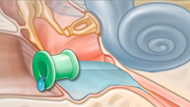Tympanocentesis for Ear Infections
Exam Overview
Tympanocentesis is the removal of fluid from behind the eardrum. The doctor uses a special needle with a tube attached to collect the sample of fluid. A culture and sensitivity test is usually done on the sample of fluid.
Before the test, your child may get medicine to help him or her relax. Or a doctor or nurse may apply medicine directly to the eardrum to numb the area. If there is a lot of earwax, it is removed from the ear before the test begins.
The child is held very still while the fluid is removed. You may be asked to help with holding your child still.
In most cases, the eardrum heals within 3 to 5 days after the procedure.
Why It Is Done
This procedure is not often done. It is sometimes done:
- When a child has severe earache, fever, and signs that an ear infection is not getting better with treatment.
- When there are signs that a child has serious complications from an ear infection.
- When an ear infection is suspected in a newborn or in a child with an impaired immune system, or when a person is suspected of having an unusual organism causing the ear infection.
- As a treatment for a child with severe ear pain. Removal of fluid from behind the eardrum relieves pressure in the ear, easing pain. This may work better than medicines for ear pain.
Results
In most cases, doing a culture and sensitivity test on fluid collected by tympanocentesis can identify the bacteria causing the infection. This helps the doctor prescribe an antibiotic that is more likely to work. Sometimes no bacteria are found in the fluid.
What To Think About
The child has to stay very still during the procedure.
Ask your doctor if your child needs to take extra care to keep water from getting in the ears when bathing or swimming. Your child may need to wear earplugs. Check with your doctor to find out what he or she recommends.
Tympanocentesis does not prevent repeated ear infections (recurrent otitis media).
Current as of: March 28, 2018
Author: Healthwise Staff
Medical Review: Susan C. Kim, MD - Pediatrics & Kathleen Romito, MD - Family Medicine & John Pope, MD, MPH - Pediatrics

